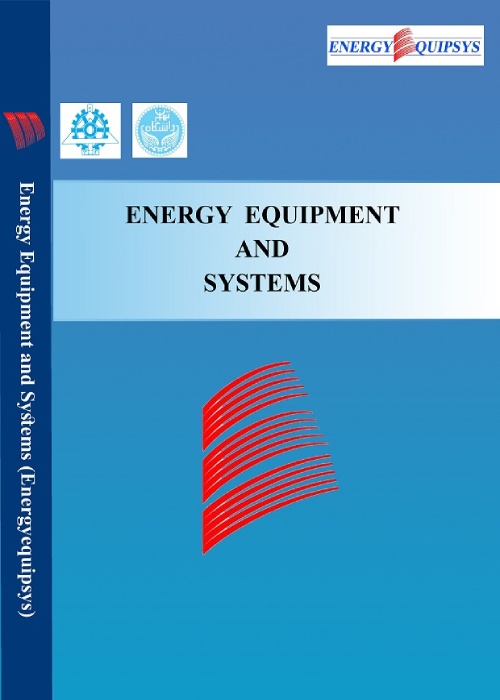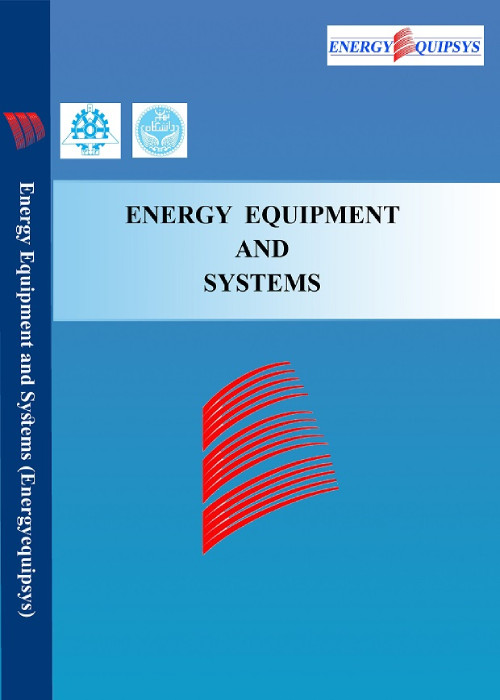فهرست مطالب

Energy Equipment and Systems
Volume:11 Issue: 4, Autumn 2023
- تاریخ انتشار: 1402/10/06
- تعداد عناوین: 6
-
-
Pages 371-386This paper presents controlling and optimizing the energy performance of buildings using smart shadings. Simulations are carried out using EnergyPlus and multi-objective optimization is performed by jEPlus+EA through NSGA-II algorithm. Optimization of control strategies is performed for a typical office room on the middle floor of a building in Tehran. Slat angle, solar radiation, and the material of smart windows are selected as decision variables. Also, the annual total building energy consumption, the predicted percentage of dissatisfaction (PPD), and the discomfort glare index (DGI) are considered as three objective functions minimized simultaneously. The weighted sum method to select the final answer of Pareto solutions is used. In the first strategy, a comparison of the results of optimization with the initial values when the angles of slats are constant and equal to 45° showed that the total annual energy consumption, DGI, and PPD indexes reduced up to 11.74%, 6.4%, and 46.6%, respectively. In the second strategy, the reductions were 28.73, 56.50, and 34.05%, respectively, in comparison with the double-glazing window. The results clearly show how the correct selection of architectural parameters and control strategies can greatly prevent energy losses while providing the thermal and visual comfort of the building occupants.Keywords: Shading control strategy, Multi-objective optimization, Thermal comfort, visual comfort, Building energy simulation
-
Pages 387-399The blade element momentum (BEM) theory has been employed to examine the aerodynamic parameters such as lift, drag, and thrust coefficient. Tip loss factor is one of the most important parameters to improve BEM theory. Glauert and Prantl represented different expression for tip loss factor which have been used commonly at literature. But the measurements and theoretical analyses show that existing tip loss factor are inconsistent and fail to predict correctly the physical behavior in the blade tip. A new tip loss factor has proposed by Shen that remedies the inconsistency. In this study, Shen formula as the newest tip loss factor has been utilized to analyze thirteen different airfoils performance. The results indicate that the blade with the RISØ-A1-24 airfoil has the shortest chord length, approximately 1.8 meters, which is considered a significant advantage due to reduced material weight and construction costs. Moreover, the RISØ-A1-24 and FFA-W3-211 Free Transition airfoils are the most effective in terms of power generation, as their total power coefficient values versus tip speed ratio changes are higher compared to other airfoils. Additionally, airfoils such as FFA-W3-241 and S814, which reach their maximum power coefficient at lower tip speed ratios, are suitable for areas with lower average wind speeds.Keywords: Wind Energy, Horizontal axis wind turbine (HAWT), BEM method, Aerodynamic performances, power coefficient
-
Pages 401-424In line with population growth and construction, the use of natural resources is increasing, which causes harm to nature, increases greenhouse gas emissions and global warming. As a result, the question arises whether architectural progress, in addition to energy optimization, has paid attention to issues related to building sustainability. In fact, the present research aims to evaluate the differences in energy consumption and compare life cycle assessment (LCA) in the context of the effects of architectural progress with the approach of creating sustainability in architecture. The results showed that architectural development in buildings has reduced CO2e carbon emissions in the energy sector by 1.3 times. However, the sector related to the materials of the modern house is almost 3.5 times more effective on the global warming potential (GWP) than the vernacular house. Nevertheless, after changing and using low-carbon materials, the impact of the material sector on GWP in the modern and vernacular houses decreased by 1.8 and 2.6 times, respectively. In fact, although the use of advanced materials has improved its thermal performance, these materials have increased its overall environmental impact in the GWP section by a factor of 2.9. As a result, the LCA study led to the creation of a regenerative design solution, the substitution of low-carbon materials, along with architectural development regarding energy optimization.Keywords: Life Cycle Assessment, Circular Economy, Regenerative Design, Carbon emissions
-
Pages 425-438Transportation is one of the important bases of the national economy of any country. The development of the transportation sector has been accompanied by economic growth. In developing countries, the development of the transportation sector and the increasing number of vehicles increase energy consumption in this sector. Therefore, the management and energy supply of this sector are two of the main priorities of the governments in these countries. In this research, taking into account the data related to the gross domestic product, the number of gasoline cars produced, the number of passengers within and outside the province, and the price of gasoline, a regression equation was written using the least squares method to determine the effect of these components on consumption. Gasoline should be evaluated. Furthermore, with Iran's gasoline consumption data from 1962 to 2021, we have forecast the gasoline consumption between 2022 and 2031 with the ARIMA method. The research results show that between 2021 and 2022, Iran's gasoline consumption had a downward trend; its amount was -0.45%; and it had an upward trend from 2023 to 2031; it grew by 52.09% between these years.Keywords: transportation, Regression, least squares method, Gasoline Consumption, ARIMA
-
Pages 439-453The use of cold thermal energy storage systems (CTES) is to decrease power consumption in air conditioning systems. CTES systems have 2 types full operating mode (FOM) and partial operating mode (POM). Objective functions are considered as exergy efficiency and total annual cost because of releasing co2 of CTES systems. Multi-objective techniques are used in MOPSO and SEAP2 algorithm to optimize target functions. The fidings achieved from multi-objective analysis indicate a difference in the optimal amounts of design points compared to single- objective optimization, objective function 1 (exergy efficiency) and objective function2 (total annual costs). Also the report of studying this model represent that because of the use of CTES, there is reduction of electricity consumption. Also because of transferring cooling load from peak hours to low consumption and reduced power consumption, we have a reduction in operating costs comparing to a traditional air conditioning system. Finally, the results show that the payback period for an CTES system in partial storage mode is 3.43 years and for a full storage system is close to 3.88 years, however, due to further reduction of operating costs in full storage mode, the total stored cost of this system after the useful life of the set (15 years) is more than partial storage type. it should be noted that the use of the CTES system decreases the production of CO2, which reduces environmental pollution. Finally, the PCMs used in the construction industry are introduced and compared with each other in terms of exergy efficiency.Keywords: Cold Thermal energy storage system, peak load, 4E analysis, energy consumption optimization
-
Pages 455-481
Thermal management systems using phase change materials (PCMs) can improve heat absorption and increase safe operating times. However, limited research has explored combining multiple PCMs within a system. This study investigates the thermal performance of a two-dimensional heat sink with varied PCM configurations. Simulations tested RT-54, CaCl2.6H2O, and n-Eicosane arranged in different ways at 5 W and 7.5 W. Key results show CaCl2.6H2O with n-Eicosane increased the time to reach 40°C by 186% compared to CaCl2.6H2O alone at 5 W. Pairing CaCl2.6H2O and RT-54 improved time to 40°C by 425%. Increased power amplified these effects. The density and latent heat fusion of PCMs were critical factors. This demonstrates combining certain PCMs extends safe operating times more than using a single material. These optimal configurations can guide thermal management system design for electronics and other applications.
Keywords: Thermal management, heat sink, Phase Change Material, numerical simulation


